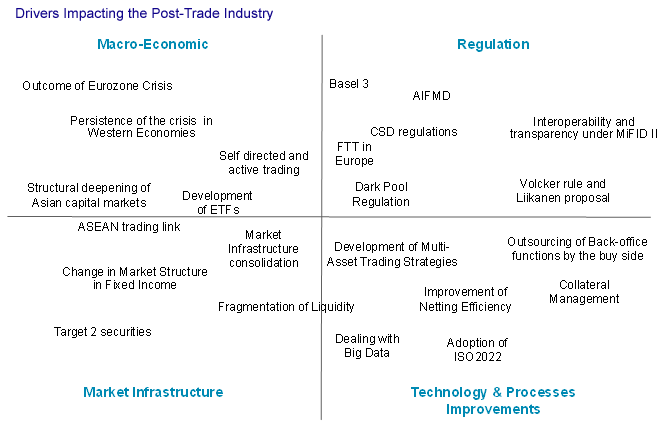Future of the Post-Trade Industry, Part I: Identifying the Drivers of Change
Abstract
Post-trade processes at financial institutions have traditionally not been given their due importance, but the crisis of has changed firms’ priorities dramatically. While downsizing enabled cost-cutting in the short run, firms had to consider long-term cost savings by improving operational efficiency and making strategic technology decisions.
In the report Future of Post-Trade Industry, Part I: Identifying the Drivers of Change, Celent identifies different drivers that are likely to influence the future of the industry. The regulatory environment has undergone rapid changes in recent times. This has created additional obligations on the mid-back office processes, particularly in the areas of risk management, reporting, and regulatory compliance. In the evolving environment it has become essential that firms address the complete trade cycle in a much more holistic way, and many buy side and sell side firms are acting in that direction.
Competition among exchanges is forcing them to improve systems to handle trading and settlement processes in a more efficient manner. Celent has identified the following drivers that will have major impact on the post-trade industry in the cash market.

“Firms are working under severe budget constraints with a large portion of the technology budget being spent on addressing regulatory and compliance issues,” says Axel Pierron, Senior Vice President with Celent’s Securities and Investments Group and coauthor of the report. “Significant investments to achieve true process efficiency and improvement are difficult to come by in the short run. However, automation of large number of manual processes frees up resources, and some firms are looking at the problem from this perspective.”
“Budget constraints are pushing firms toward considering outsourcing mid-back office operations,” says Arin Ray, Analyst with Celent’s Securities & Investments Group and coauthor of the report. “Given that all firms have to adhere to same set of regulatory requirements, some vendors are considering coming up with a utility model of offering that will allow multiple firms to use a basic core platform to address many of these issues. However, customizing such an offering to suit firm specific needs, especially for large financial institutions, will be a challenge.”
The report begins with a discussion on the functions served by the post-trade industry and the actors playing in the market. We then look at the latest trends that are impacting different participants to provide a good snapshot of the market conditions. We then try to forecast how the industry will look five years down the line. For that we first try to identify the main drivers that will be influencing the post-trade environment in the years ahead. The next chapter discusses each of the drivers in detail, and how they will impact the post-trade ecosystem. In a separate report we analyze the quantitative impact of these drivers under different assumptions and scenarios.

